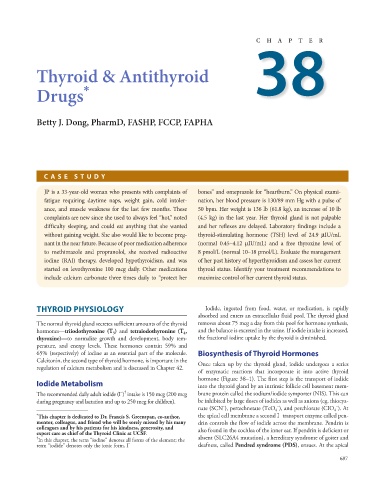Page 701 - Basic _ Clinical Pharmacology ( PDFDrive )
P. 701
38
A
P
C
H
T
R
E
Thyroid & Antithyroid
Drugs *
Betty J. Dong, PharmD, FASHP, FCCP, FAPHA
C ASE STUD Y
JP is a 33-year-old woman who presents with complaints of bones” and omeprazole for “heartburn.” On physical exami-
fatigue requiring daytime naps, weight gain, cold intoler- nation, her blood pressure is 130/89 mm Hg with a pulse of
ance, and muscle weakness for the last few months. These 50 bpm. Her weight is 136 lb (61.8 kg), an increase of 10 lb
complaints are new since she used to always feel “hot,” noted (4.5 kg) in the last year. Her thyroid gland is not palpable
difficulty sleeping, and could eat anything that she wanted and her reflexes are delayed. Laboratory findings include a
without gaining weight. She also would like to become preg- thyroid-stimulating hormone (TSH) level of 24.9 μIU/mL
nant in the near future. Because of poor medication adherence (normal 0.45–4.12 μIU/mL) and a free thyroxine level of
to methimazole and propranolol, she received radioactive 8 pmol/L (normal 10–18 pmol/L). Evaluate the management
iodine (RAI) therapy, developed hypothyroidism, and was of her past history of hyperthyroidism and assess her current
started on levothyroxine 100 mcg daily. Other medications thyroid status. Identify your treatment recommendations to
include calcium carbonate three times daily to “protect her maximize control of her current thyroid status.
THYROID PHYSIOLOGY Iodide, ingested from food, water, or medication, is rapidly
absorbed and enters an extracellular fluid pool. The thyroid gland
The normal thyroid gland secretes sufficient amounts of the thyroid removes about 75 mcg a day from this pool for hormone synthesis,
hormones—triiodothyronine (T ) and tetraiodothyronine (T , and the balance is excreted in the urine. If iodide intake is increased,
3
4
thyroxine)—to normalize growth and development, body tem- the fractional iodine uptake by the thyroid is diminished.
perature, and energy levels. These hormones contain 59% and
65% (respectively) of iodine as an essential part of the molecule. Biosynthesis of Thyroid Hormones
Calcitonin, the second type of thyroid hormone, is important in the Once taken up by the thyroid gland, iodide undergoes a series
regulation of calcium metabolism and is discussed in Chapter 42.
of enzymatic reactions that incorporate it into active thyroid
hormone (Figure 38–1). The first step is the transport of iodide
Iodide Metabolism into the thyroid gland by an intrinsic follicle cell basement mem-
− †
The recommended daily adult iodide (I ) intake is 150 mcg (200 mcg brane protein called the sodium/iodide symporter (NIS). This can
during pregnancy and lactation and up to 250 mcg for children). be inhibited by large doses of iodides as well as anions (eg, thiocya-
−
−
−
nate (SCN ), pertechnetate (TcO ), and perchlorate (CIO ). At
4
4
−
* This chapter is dedicated to Dr. Francis S. Greenspan, co-author, the apical cell membrane a second I transport enzyme called pen-
mentor, colleague, and friend who will be sorely missed by his many drin controls the flow of iodide across the membrane. Pendrin is
colleagues and by his patients for his kindness, generosity, and also found in the cochlea of the inner ear. If pendrin is deficient or
expert care as chief of the Thyroid Clinic at UCSF.
† In this chapter, the term “iodine” denotes all forms of the element; the absent (SLC26A4 mutation), a hereditary syndrome of goiter and
term “iodide” denotes only the ionic form, I − deafness, called Pendred syndrome (PDS), ensues. At the apical
687

